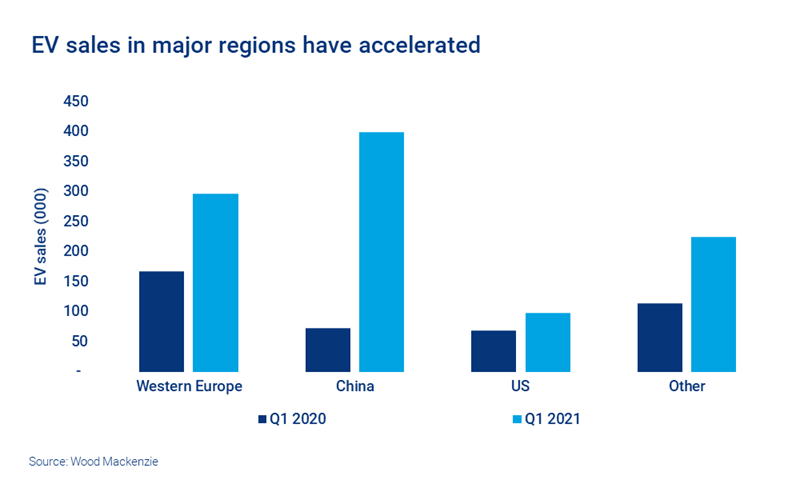Electric vehicles continue to get the green light
Steady momentum behind climate action drives a leap in global EV sales
1 minute read
In our last long-term outlook, global sales of electric passenger vehicles (EVs) were estimated to reach 74 million units a year by 2050. In Q1 of 2021, sales rocketed to 550,000 – a 66% increase over the same period last year. This surge in activity has seen our outlook upgraded to 950 million EVs on the road by 2050.
So, what’s driving this accelerating growth – and what does it mean for internal traditional combustion engine (ICE) vehicle sales? We explore the road ahead in detail in our Road Transport 2021 Outlook to 2050. Fill in the form for a complimentary extract, and read on for an introduction.
EV sales have increased in all major regions. As the chart shows, China has provided the largest boost, but sales in Western Europe have almost doubled since 2020. Our outlook shows that by 2050 54% of EVs will be on the roads of the APAC region, with North America and Europe following closely, with 23% and 20% respectively.
EVs share of the market has also increased from 2.9% to 4.5% year-on-year – an extremely positive sign for adoption trends.
EVs will overtake sales and stock of traditional ICEs by 2033 and 2044, respectively.
Is the beginning of the end for the ICE vehicle?
Global ICE vehicle sales are in a terminal decline, with sales plummeting to only 20% of new car sales by 2050.
Net-zero emissions targets proliferated during 2020 and early 2021 and are a key driver. Countries representing more than 50% of global car sales have expressed their intent to be carbon neutral and phase out ICE vehicles. China, the leader in EV sales, plans to phase out traditional ICE cars by 2035. Meanwhile, almost all large automakers have set carbon neutral targets, most coalescing around 2050.
Almost half of the remaining global ICE stock in 2050 will be in Africa, Latin America, Middle East and Russia & Caspian regions – even though they only account 18% of the global vehicle stock.
For more on the policy landscape and specific automaker targets fill in the form to access a complimentary extract from the full report.
Tesla is leading in the EV race
Electric car pioneer Tesla continues to lead EV sales, with just over half a million vehicles sold in 2020. Automakers GM and VW are vying for second place. VW, arguably the most aggressive of the traditional OEMs, could threaten Tesla’s leading position by the end of the decade. Both Tesla and VW aim to manufacture their own cells, boosting their profitability.
Consumers, too, have a close eye on the economics. And while most are in no small part driven by climate concerns, the financial benefits of switching to zero emission, plug-in hybrids and battery electric vehicles is also a factor. Price parity with ICE vehicles at point of sale has been achieved in the luxury sedan segment and will extend beyond that niche ahead of original projections – a change that will really see EV adoption accelerate.
What’s the forecast for commercial EV sales? Can the charging infrastructure keep pace with EV sales growth? Read Road Transport 2021 Outlook to 2050 in full to find out, or fill in the form at the top of the page for a complimentary extract that includes:
- Executive summary
- Policy landscape by country
- Automaker outlook – an overview
- Charts on light vehicle and commercial vehicle sales, and more.





